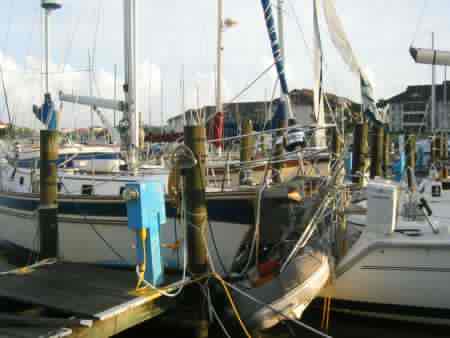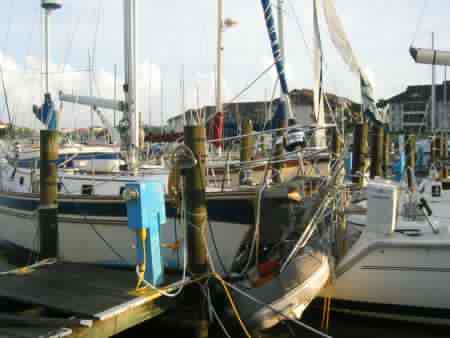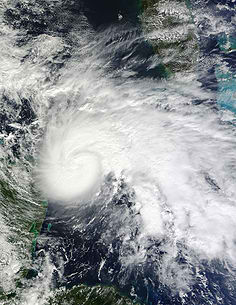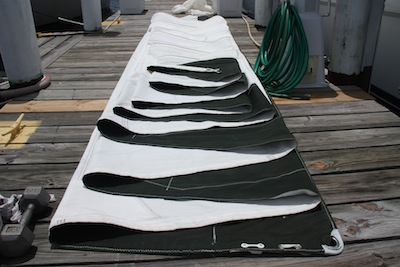With hurricane season fast approaching, lots of folks are getting their boats ready to leave for the summer. Our experience with Hurricane Charley was in a marina, we didn’t have a chance to haul and given the condition of the boatyard afterward, in our particular situation, the boat ended up safer in the water. If we had the choice again, we’d weigh the locations and decide if we should haul or leave the boat in the water – you’ll need to make the same determination for your particular situation. Regardless, if your boats in a marina, it seems like a good time to do a quick recap of the Hurricane Preparation information on Commuter Cruiser. A lot of these tips are important out of the water too.
We had the good fortune to survive a direct hit with a Cat 4 hurricane, Charley in August 2004 … only months before we planned to leave the US to cruise the Western Caribbean. Were all those years of planning and preparing the boat about to be for naut? For more on Winterlude’s experience with Hurricane Charley, click here.
For more information about surviving a hurricane at anchor, click here to read about Dave & Carolyn Shearlock’s adventures on Que Tal during Hurricane Marty.
In A Marina:
1. Remove All Windage. ALL windage means all windage. We were lucky in Hurricane Charley, but we learned a lot about what 140 mph winds can do to a marina in just a few hours. These day when the boat is left in a Hurricane Zone like this summer (2011), we remove everything that’s removable, sails, canvas – bimini, dodger, shadecloths, KISS wind generator blades, dorades, removable boarding ladder, mack pack, lifering/horseshoe, portable generator, flag staff, flag, spreader flags, empty jerry cans, anything loose on deck gets stuffed below. Some cruisers go so far as to take their outboards and grills below. Because we’re out of room, ours are left in place above, but it would definitely be better below. If you have a dinghy, rollup or air floor, that can stow below, do it. Once you’re done, stand on deck and imagine a wind that you cannot stand against blowing for hours on your boat – anything else you should take below? How about solar panels? Are they secure?
2. Do NOT even think about wrapping a roller furling jib with a spinnaker halyard or extra line and leaving it in place. We’ve seen more masts broken because owners didn’t think it was necessary to remove the roller furling jib. For more on removing roller furling sails, click here.
3. Look up, take note of sailboat masts in neighboring slips. During a hurricane, your mast will be swinging wildly – you don’t want it to tangle with the boat next door. If necessary, reposition the boat in the slip – turn it around, pull it back a few feet, whatever will make it less likely that your mast and the next slip’s mast will collide.
4. Create a literal spiderweb of lines to keep your boat centered both side to side and fore and aft in the slip. Double your lines and make sure the chafe guard is in place anywhere lines touch anything. Use high quality lines and look for the most secure pilings/places to tie them. Many boats were OK in Charley until a critical piling snapped. If your marina has wooden pilings in poor shape, see what you can do to work around them. For more on Dock Lines in a hurricane, click here. Also it’s a good idea to leave extra lines in the cockpit for marina dockwalkers and your caretaker. For fixed docks, normally you should make all the lines adjustable from the boat in case the docks are underwater.
5. Get all your fenders out and position them around the boat/on the dock using your best guess as to where they will do the most good.
6. Make sure the batteries are topped off – if they’re wet cells, make sure to top off the water too. Electricity will likely be out and it could be out for several days.
7. Seacocks should be shut unless there’s a compelling reason to leave one open.
8. Ensure all hatches and companionways are watertight and shut securely.
9. Make sure the bilge pump and float switch are working correctly.
10. Check to make sure all cockpit drains are clear and not clogged or covered.
11. Lock the boat and leave, go to someplace inland and secure and wait.
This is the hardest part, the waiting. We know from experience as we waited for three days to hear news of Winterlude after we watched Hurricane Charley on TV take a direct hit on our marina. Our floating home is part of us, but still is just a “thing” and not family. If we lose the boat we’ll be devastated, but it’s still just an inanimate object (although it certainly doesn’t feel that way).
Hang on, GOOD LUCK! We’re thinking about everyone in this hurricane’s path – particularly friends with boats in the Bahamas as Irene passed yesterday – no news yet.













